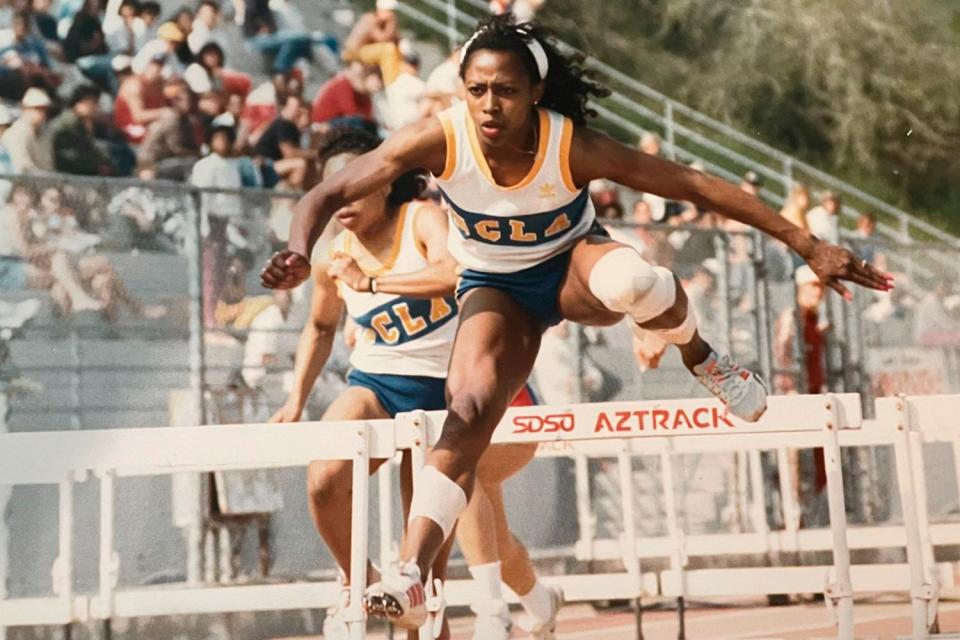Olympic Track Star Gail Devers Opens Up About Living with Graves' Disease and Thyroid Eye Disease

jessica McGowan
Gail Devers was at the peak of her collegiate running career at UCLA when her health started to fail.
"My hands were constantly shaking, I had extreme fatigue and my eyes started bothering me," the Olympic gold medalist tells PEOPLE. "I lost so much weight that I looked emaciated, and I had sores on my face and my skin was peeling off."
Despite the strange symptoms and feeling unusually weak, she made it to the 1988 Olympics in Seoul. But at her hurdling and sprinting events, her body would not perform. "Something was definitely wrong," says Devers, 55. "I got there, and the bottom fell out — I ran slower than the first time I'd ever stepped on the track."
She came back from the Games and embarked on a three-year search for answers involving countless doctor visits. The 5'3"-inch athlete remembers her hair falling out in clumps and her weight dropping from 125 lbs. to 79 lbs. Friends, family members and teammates would ask if she was okay, but, she says, "I got tired of having to answer those questions — and of having no answers for myself."

Courtesy Gail Devers
Her conditioned worsened and her self-esteem took a hit. One day she was sitting in a park and a kid playing nearby asked his mom what was wrong with Devers, saying she "looks like a monster."
Devers shudders at the memory. "I went in my house. I looked at myself in the mirror, at the skeleton of the person that was looking back at me. And I covered my mirrors with black sheets." Devers went through a period of depression, staying in her house, not answering the door, not answering the phone.
RELATED: Wendy Williams Opens Up About Battling Graves' Disease In the Midst of Menopause
Then in 1990, she ran into her UCLA track team physician for the first time in a while, and she noticed Devers' visible goiter, a swelling of the thyroid in the neck. "That was the first time I had ever even heard of a thyroid," Devers says.
Within a week, a specialist had diagnosed her with Graves' Disease, an autoimmune disorder in which the immune system attacks the thyroid gland. It affects about 1 in 100 Americans, and women are 5 to 8 times more likely to get it than men.
"Graves' hyperthyroidism can turn a high-functioning, extremely productive individual into a poorly functioning one over a period of weeks to months," says Dr. Henry Burch, M.D., an endocrinologist and cochair for the American Thyroid Association.
"The disease can be mistaken for other disorders, so patients with suggestive symptoms should inquire about the possibility of a thyroid disorder, which can be easily confirmed or excluded with a simple blood test," he adds.
Devers began taking radioactive iodine treatment which destroys the portion of the thyroid that produces hormones. By 1991 she found herself training again, this time for the world championships to qualify for the Olympics in Barcelona in 1992, where she won gold in the 100 meter dash — a victory she would repeat at the Atlanta Olympics in 1996, along with winning gold in the 4×100-meter relay.

Popperfoto/getty
Still, not all of her symptoms had improved. "I still had the bulging eyes, the redness, the tearing." At the Games, she says, "I was running the hurdles, but it was like I was looking through film — it was blurry."
She remembers feeling helpless: "I just assumed my symptoms were caused by my Graves', and that there was nothing I could do about it," she says.
It took another 30 years before the final mystery of Devers' health was solved. An online quiz about eye health led her to suspect she had Thyroid Eye Disease, a rare disorder that few Graves' patients get, but one that almost always occurs in the setting of Graves'. TED presents with uncomfortable and embarrassing symptoms such as irritation, pain, tearing, swelling and in extreme cases, loss of vision.
RELATED: E! News' Morgan Stewart Diagnosed with Thyroid Condition After Scary Symptoms: 'I Was Terrified'
"Quality of life can become greatly diminished in patients with TED due to visual disability, as well as altered appearance," says Dr. Burch.
For Devers it was a huge relief to get help for the condition, which includes eyedrops and working with her doctor to determine treatment.
"I'm a sprinter," says Devers, who lives in Atlanta with her husband Mike and daughters Karsen, 16, and Legacy, 14. "I'm supposed to get to the finish line first, and now it has taken me 30 years after learning I have Graves' disease to know I have TED."
"If you have Graves' disease, start paying attention to your eyes," she warns. "Don't assume like I did that it's just a part of your Graves' disease and you have to deal with it. You don't."
The experience has motivated her to help others.
"I don't want anyone to have to go through what I went through," says Devers. "I've got a baton full of knowledge and want to pass it on to help people advocate for their health."

 Yahoo Finance
Yahoo Finance 